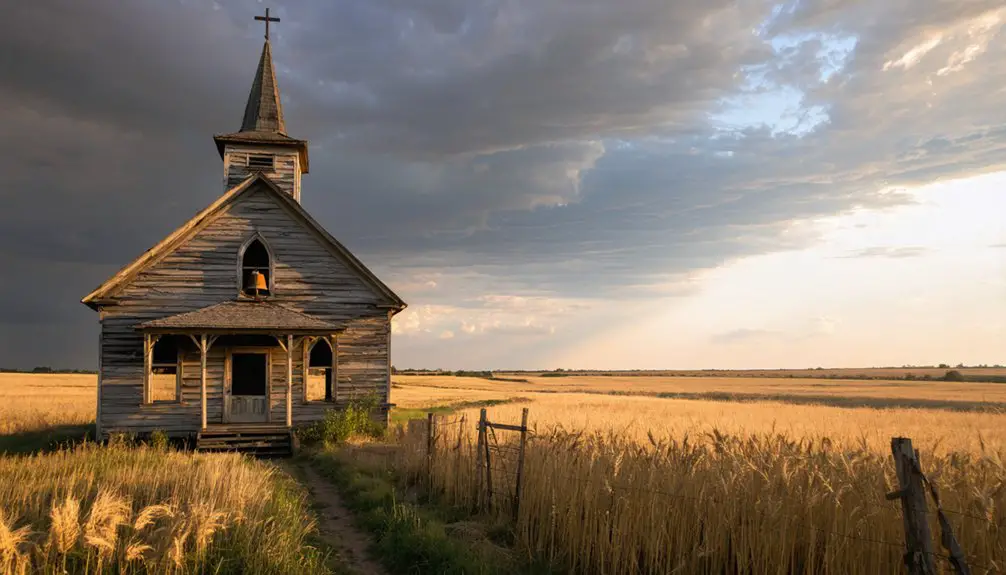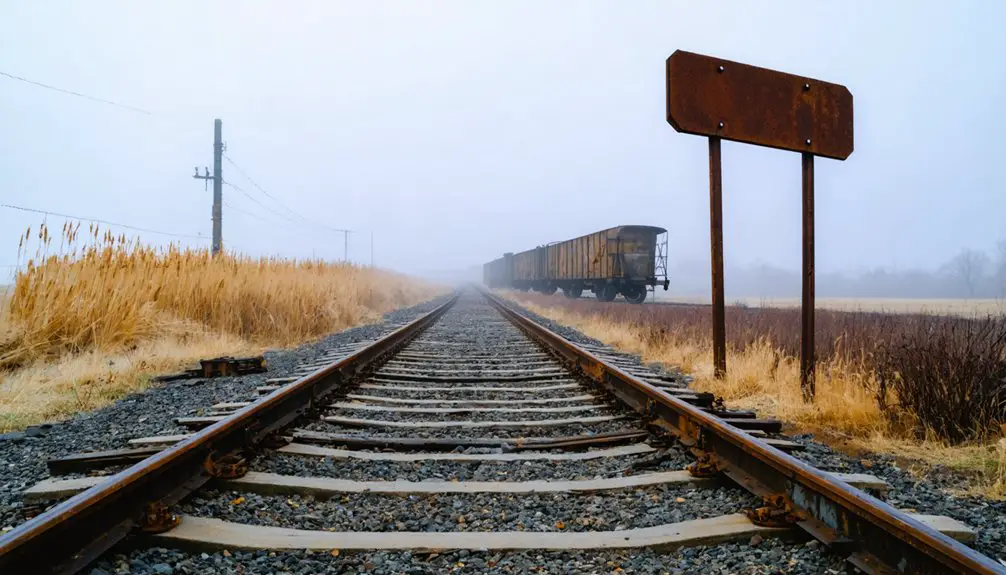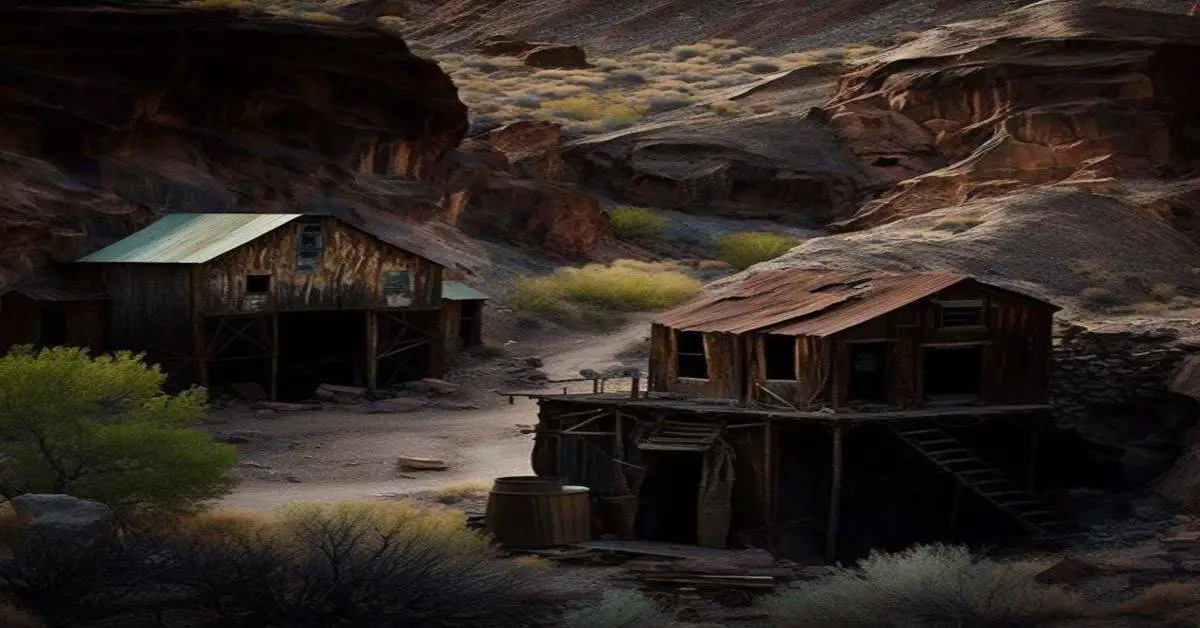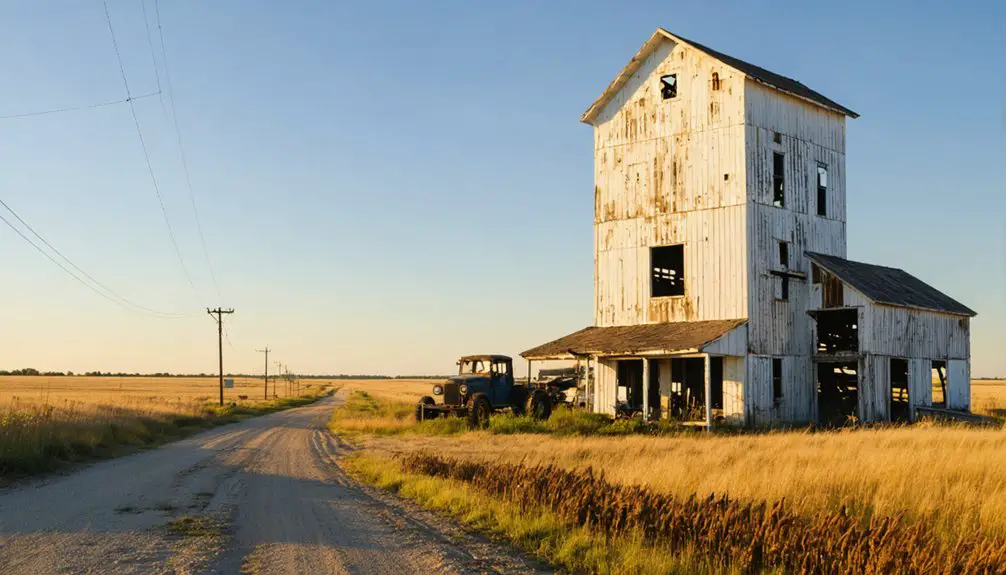You’ll find Aurelia, North Dakota along a former Great Northern Railway branch line west of Minot. Established in 1919-1920, this planned railroad settlement attracted German and Scandinavian immigrants who built a farming community around wheat and flaxseed cultivation. The town thrived on rail-dependent agriculture until mid-century, when improved roads and changing transportation needs led to its decline. Today, private farmland covers most traces of this once-vibrant prairie settlement, though untended cemeteries still tell its story.
Key Takeaways
- Aurelia was a planned railroad settlement developed by Great Northern Railway during 1919-1920, attracting settlers from Germany and Scandinavia.
- The town flourished as an agricultural hub with rich black loam soil, primarily focusing on wheat and flaxseed cultivation.
- Economic decline began mid-century when improved roads and reduced railroad service diminished the town’s strategic importance.
- The community’s social life centered around Lutheran and Catholic churches, with strong cultural bonds among early settlers.
- Today, Aurelia exists as private farmland with restricted access, leaving only foundations and untended cemeteries as historical markers.
The Rise and Fall of a Railroad Settlement
While many North Dakota towns sprang up along the Great Northern Railway‘s expanding network in the late 19th century, Aurelia emerged as a planned railroad settlement during the company’s 1919-1920 branch line development west of Minot.
You’ll find that railroad expansion played a vital role in Aurelia’s establishment, with the Great Northern strategically platting townsites and attracting settlers from Germany and Scandinavia through overseas agencies. The railroad’s massive development brought 5,400 miles of track to North Dakota by 1920. Extensive administrative correspondence documented the company’s systematic approach to town development.
The town’s economic resilience initially thrived on agricultural exports and railroad-dependent businesses, but this prosperity wouldn’t last.
By mid-century, you could see Aurelia’s decline taking shape as improved roads favored automobile transportation and the railroad began consolidating operations in larger hubs.
The town’s dependence on a single branch line ultimately proved fatal when the Great Northern reduced service, leading to Aurelia’s abandonment.
Life in Early Aurelia
Despite the harsh realities of prairie life, Aurelia’s early settlers forged a remarkable community built on mutual support and determination.
You’d find immigrants from Germany, Norway, Sweden, and other European nations battling extreme weather while cultivating wheat and flaxseed on their 160-acre homesteads. Without doctors or established infrastructure, pioneer resilience emerged through neighbors helping neighbors. Following the Dakota Boom period, farm settlements exploded from just 1,700 to over 50,000 across the territory. With temperatures ranging from 124 degrees to minus 60, settlers faced some of the most extreme climate variations in America.
The town’s social fabric centered on Lutheran and Catholic churches, where you’d witness the blending of Old World traditions with frontier necessities.
Community bonds strengthened through shared hardships and celebrations. Rather than urban isolation, settlers embraced meaningful connections in their prairie home. They’d gather for community events, support newcomers, and pool resources during tough times.
Every individual’s contribution mattered in this close-knit society, creating a unique cultural identity on the North Dakota plains.
Historical Significance in Ward County
Like many settlements in Ward County during the late 1800s, you’ll find Aurelia’s origins tied to the era’s railroad expansion and agricultural development patterns that shaped North Dakota’s landscape.
You can trace Aurelia’s growth through its role as a small farming hub, where it served surrounding homesteaders during Ward County’s peak settlement period between 1885 and the early 1900s.
You’ll notice how Aurelia’s eventual decline mirrors broader economic shifts in Ward County, as mechanized farming and migration to larger centers like Minot transformed the region’s settlement patterns. The town’s last remaining structures fell into disrepair during a period of heavy rain and eerie ambiance. Similarly, the nearby town of Tagus experienced significant changes when a highway underpass built in 1928 diverted traffic away from its center.
Railroad Settlement Hub Growth
As the Northern Pacific Railway pushed westward from Duluth in 1871, North Dakota’s transformation into a railroad settlement hub began taking shape, particularly in Ward County.
You’ll find that railroad expansion progressed swiftly, with crews laying an impressive 3.5 miles of track daily as they extended westward through Minot by 1885.
James J. Hill’s privately-funded Great Northern Railroad revolutionized the region’s community dynamics through its Dakota & Great Northern Townsite Company.
By establishing Aurelia along its branch line and actively recruiting settlers from Germany and Scandinavia, the railroad created a crucial transportation hub.
The 1916 townsite development included strategic planning for 54 businesses, while connecting rail service and river ferry access transformed Aurelia into a bustling center for commerce, agriculture, and immigration in Ward County.
Agricultural Community Development Pattern
When Ward County’s agricultural development took root in the late 1870s, the region quickly established itself as North Dakota’s premier farming hub through diverse crop production and innovative farming practices.
You’ll find that crop diversification and community resilience defined Ward County’s agricultural success, with land values soaring from worthless to $50 per acre within just twelve years.
The county’s rich black loam soil created optimal conditions for unprecedented crop yields and farming success. By 1947, the adoption of DDT spraying machines revolutionized pest control across hundreds of local farms.
- Leading flax producer with 91,156 acres yielding 16 bushels per acre
- 500% increase in corn acreage by 1911, showing agricultural adaptability
- Mixed farming integration with cattle, hogs, and sheep before wheat dominance
- Pioneer farmers, mainly Scandinavian, bringing Midwest farming expertise
- Introduction of mechanized farming through horse-powered threshers and self-binders
These agricultural patterns transformed Ward County’s landscape, creating a robust farming community that withstood economic challenges through strategic crop diversity.
Migration and Economic Decline
The thriving agricultural foundation of Ward County couldn’t shield Aurelia from the dramatic economic shifts that would seal its fate.
As steam locomotives gave way to modern engines, the town’s strategic position every eight miles along the rail line lost its significance. This transformation triggered devastating outmigration trends, with younger residents seeking opportunities in larger urban centers.
Economic shifts hit hard as farming mechanization reduced labor needs, and the consolidation of agricultural lands diminished local commerce. Like many other ghost towns of ND, Aurelia’s story has been preserved through historical documentation and photography.
You’ll find evidence of this decline in the closure of Aurelia’s essential services – the post office that opened in 1910, general stores, blacksmith shops, and community halls all vanished.
Today, only scattered remnants and farmsteads mark where this once-bustling Ward County settlement stood, a reflection of rural America’s changing landscape.
What Remains Today

Modern visitors to Aurelia will find only scattered remnants of this once-vibrant North Dakota settlement, with several deteriorating buildings standing as silent witnesses to the town’s past.
Structural decay has taken its toll on wooden buildings, while harsh weather continues to erode the remaining cultural remnants. You’ll encounter:
- Weathered churches and schoolhouses lacking protective metal sheeting
- Abandoned post office ruins marked by no trespassing signs
- Minimally maintained roads leading to private farmlands
- Untended cemeteries serving as historical markers
- Reclaimed town sites where vegetation obscures old foundations
Today, the site exists primarily as private farmland, with restricted access limiting exploration to roadside viewing.
Local historical societies document the town’s legacy, though preservation efforts remain minimal due to funding constraints and private ownership issues.
Agricultural Legacy and Land Use
Agricultural prominence defined Aurelia’s identity throughout its existence, with wheat cultivation serving as the cornerstone of local farming operations from the late 1800s through the early 20th century.
Wheat farming shaped Aurelia’s character from its founding, establishing the community’s agricultural foundation in the late nineteenth century.
You’ll find evidence of this legacy in the grain elevator infrastructure that once powered the local economy, connecting farmers to broader markets through rail networks.
As farming practices evolved, you’d have witnessed the shift from pure wheat cultivation to diverse operations incorporating crop rotation and livestock integration.
Local farmers adapted by introducing oats, durum, barley, and flax, while beef cattle became an important revenue stream.
The farmsteads that dotted Aurelia’s landscape featured the classic structures of the era: barns, granaries, and livestock pens, all testifying to the agricultural ingenuity that shaped this North Dakota community.
Transportation’s Role in Aurelia’s Destiny

When railroad companies expanded across North Dakota in the early 1900s, Aurelia emerged as one of many strategic settlements along their extensive land holdings between Bismarck and Jamestown.
The transportation evolution that shaped Aurelia’s fate reflects the broader story of rail infrastructure’s rise and decline across the northern plains.
- Steam locomotives initially required frequent stops, making Aurelia’s location essential for refueling and maintenance.
- Agricultural prosperity depended on rail access for shipping crops and livestock to market.
- As diesel engines replaced steam power, the need for frequent stops diminished.
- The shift to trucking and highways bypassed many rail-dependent communities.
- Without investment in alternative transportation infrastructure, Aurelia lost its economic lifeline.
Like many railroad towns, Aurelia couldn’t survive the changing transportation landscape, ultimately succumbing to isolation and abandonment.
Documenting a Lost Community
Despite extensive efforts to document North Dakota’s ghost towns, Aurelia’s historical record remains frustratingly sparse, with photography initiatives only beginning in 2003.
You’ll find that most evidence of this lost community comes from scattered oral histories and incomplete local records, making it challenging to piece together a complete picture of life in this prairie settlement.
While historical societies have worked to preserve community memories through collecting stories and rescuing buildings from similar ghost towns, Aurelia’s physical remains have largely vanished into privately-owned farmland.
The town’s documentation primarily exists through informal channels like social media and digital platforms, where history enthusiasts share what little they’ve uncovered.
Without extensive early photographs or detailed maps, you’re left to imagine much of Aurelia’s original appearance through comparisons with similar North Dakota settlements.
Frequently Asked Questions
Were Any Notable Crimes or Tragedies Reported in Aurelia’s Brief History?
You won’t find any documented crime incidents or tragic events in historical records. The town’s decline stemmed purely from economic hardships and environmental challenges during the Great Depression and Dust Bowl.
What Happened to the Original Residents After Leaving Aurelia?
You’ll find relocation stories show residents moved to larger towns like Bismarck and Fargo, seeking better opportunities. Many integrated into new communities while maintaining family ties and preserving memories through historical societies.
Did Any Native American Settlements Exist at the Aurelia Site Before?
Keep your eyes peeled, but historical evidence doesn’t confirm specific Native American tribes settled at this exact spot, though several Plains tribes like Dakota and Mandan certainly roamed the broader region.
What Was the Average Property Value of Buildings in Aurelia?
You’ll find current median property values around $120,000, with some homes available for $40,000-$50,000. Historical property valuation data isn’t available in reliable records from Aurelia’s earlier periods.
Were There Any Local Legends or Folklore Associated With Aurelia?
Despite searching through records covering 100+ years of North Dakota history, you won’t find documented ghost stories or folklore traditions specific to Aurelia. The town’s quick decline left little time for legends to develop.
References
- https://www.onlyinyourstate.com/experiences/north-dakota/ghost-towns-nd
- https://www.youtube.com/watch?v=eBfraH7yoGw
- https://ndtttp.genealogyvillage.com/ward/index.htm
- https://ghostsofnorthdakota892857007.wordpress.com/2017/03/28/the-story-of-how-ghosts-of-north-dakota-began/
- https://ghostsofnorthdakota892857007.wordpress.com
- https://www.history.nd.gov/hp/PDFinfo/North-Dakota-Railroads-MPDF-Final-corrected.pdf
- https://writinforthebrand.com/the-railroad-and-settlement-in-early-north-dakota/
- https://digitalcommons.unl.edu/context/greatplainsquarterly/article/2671/viewcontent/Hudson.pdf
- https://www.mnhs.org/library/findaids/01064.xml
- https://pastmaps.com/explore/us/north-dakota/ward-county/aurelia/metal-detecting



